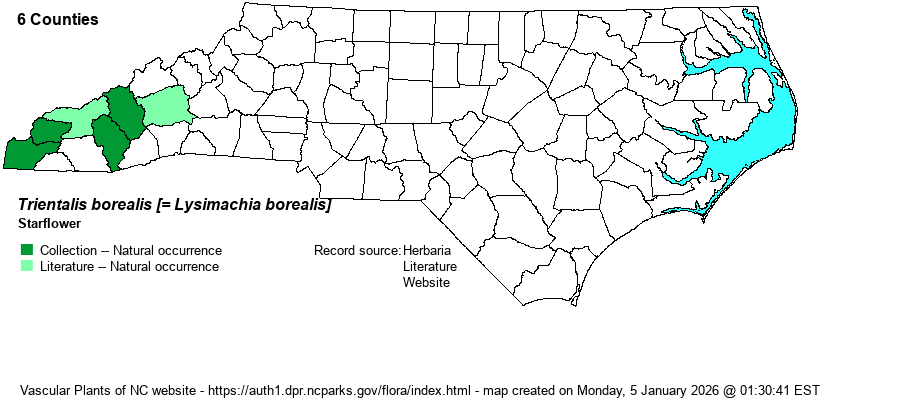| Author | Rafinesque | |
| Distribution | [Note -- The NC Plant Conservation Program and the NCNHP name this species as Lysimachia borealis.] Scattered in the southwestern Mountains, from Haywood County to the southwest, and formerly from Buncombe County. Remarkably, even though the NCNHP database now has nine current records, this species was unknown in NC when RAB (1968) was published; according to Weakley (2018), it was first discovered in the state in 1988. It seems highly unlikely that such a distinctive species could have been overlooked at that time. However, this species is of rather small stature and has a fairly ephemeral blooming period, and it is also not in the more frequently botanically explored areas of the mountains (fide Bob Dellinger).
This is a Northern species, numerous and found in nearly every county south to NJ, PA, MI, and MN; southward it ranges down the Appalachians to northern GA.
| |
| Abundance | Formerly extremely rare to absent, but in recent times now very rare to rare, but oddly just in the southern Mountains. Ought to be eventually found in the central and northern Mountains, as it is found in the VA Mountains that include counites along the state line. This is a State Threatened species, though is listed by the NC Plant Conservation Program under the name of Lysimachia borealis. The NCNHP State Rank of S1 is reasonably accurate, but with nine current records in their database -- plus a new photo (May 2021) from Swain County on iNaturalist, including six with occurrences considered to be excellent or good in quality, the website editors suggest S1S2 is somewhat more accurate now. | |
| Habitat | This species occurs at rather high elevations, mostly in Northern Hardwood Forests or in other rich slope areas, even into some places with second growth. It is not truly a species of Rich Cove Forests in NC, or otherwise it might be more widespread and have been discovered much earlier in time. | |
| Phenology | Blooms in May and June, and fruits shortly after flowering. | |
| Identification | This is a very distinctive herb, very hard to overlook, even in leaf; it is unbranched and grows only to about 6-7 inches high. The stem is thin and naked, up to the single whorl of 5-9 lanceolate leaves, each leaf being about 2-3 inches long and with an acuminate tip and an entire margin. Interestingly, the leaves are generally not all the same size, some clearly "runts" as compared with others. Just above the whorl grow often just 2 small, white, star-like flowers, each about 3/4-inch across, on very slender pedicels. As with the leaves, there are often about 5-9 petals, with 7 being the average number. Thus, it is hard to miss a plant with leaves and flowers often in "sevens"! After the flower is spent, the entire flower, not just a single petal, falls to the ground. The plant is well known as occurring in sizable colonies of dozens to a few hundred plants. The colony discovered in 1988 had a "minimum of 50,000 stems estimated ... locally dominant in area of a hectare or so" (NCNHP database). | |
| Taxonomic Comments | The most recent analysis (2018 journal paper) places this species back in the genus Trientalis, not in Lysimachia where it was an uncomfortable fit for us older geezers.
| |
| Other Common Name(s) | Northern Starflower, Maystar | |
| State Rank | S1 [S1S2] | |
| Global Rank | G5 | |
| State Status | T | |
| US Status | | |
| USACE-agcp | | |
| USACE-emp | | |

